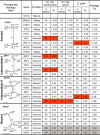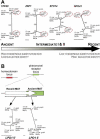Convergent evolution of chromosomal sex-determining regions in the animal and fungal kingdoms
- PMID: 15538538
- PMCID: PMC526376
- DOI: 10.1371/journal.pbio.0020384
Convergent evolution of chromosomal sex-determining regions in the animal and fungal kingdoms
Abstract
Sexual identity is governed by sex chromosomes in plants and animals, and by mating type (MAT) loci in fungi. Comparative analysis of the MAT locus from a species cluster of the human fungal pathogen Cryptococcus revealed sequential evolutionary events that fashioned this large, highly unusual region. We hypothesize that MAT evolved via four main steps, beginning with acquisition of genes into two unlinked sex-determining regions, forming independent gene clusters that then fused via chromosomal translocation. A transitional tripolar intermediate state then converted to a bipolar system via gene conversion or recombination between the linked and unlinked sex-determining regions. MAT was subsequently subjected to intra- and interallelic gene conversion and inversions that suppress recombination. These events resemble those that shaped mammalian sex chromosomes, illustrating convergent evolution in sex-determining structures in the animal and fungal kingdoms.
Conflict of interest statement
The authors have declared that no conflicts of interest exist.
Figures







References
-
- Altschul SF, Gish W, Miller W, Myers EW, Lipman DJ. Basic local alignment search tool. J Mol Biol. 1990;215:403–410. - PubMed
-
- Cai L, Taylor JF, Wing RA, Gallagher DS, Woo SS, et al. Construction and characterization of a bovine bacterial artificial chromosome library. Genomics. 1995;29:413–425. - PubMed
Publication types
MeSH terms
Associated data
- Actions
- Actions
- Actions
- Actions
Grants and funding
LinkOut - more resources
Full Text Sources
Other Literature Sources
Medical

